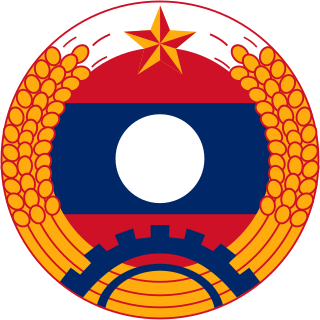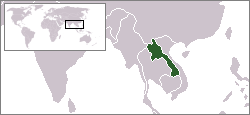Related Research Articles

Laos, officially the Lao People's Democratic Republic, is a socialist state and the only landlocked country in Southeast Asia. At the heart of the Indochinese Peninsula, Laos is bordered by Myanmar and China to the northwest, Vietnam to the east, Cambodia to the southeast and Thailand to the west and southwest. Its capital and largest city is Vientiane.

The economy of Laos is a rapidly growing lower-middle income developing economy. Being one of four remaining socialist states, the Lao economic model resembles the Chinese socialist market and/or Vietnamese socialist-oriented market economies by combining high degrees of state ownership with an openness to foreign direct investment and private ownership in a predominantly market-based framework.

The Lao People's Armed Forces is the armed forces of the Lao People's Democratic Republic and the institution of the Lao People's Revolutionary Party, who are charged with protecting the country.
Le Rénovateur is the only French-language newspaper in the Lao PDR (Laos). It is published weekly by the Lao Press in Foreign Languages, which is a specialised agency of the Ministry of Information and Culture
The Vientiane Times is a bilingual English and Lao newspaper, published daily in Vientiane, Laos. Established in 1994 as a weekly, the paper was started by an agency, Lao Press in Foreign Languages, under the Ministry of Information and Culture. It went to twice per week in 1996 and daily in 2004. It runs to 16 pages.

The situation of human rights in Laos has often been, and remains, a recognized cause for serious concern. Laos is one a handful of Marxist-Leninist governments and is ruled by a one-party communist government backed by the Lao People's Army in alliance with the Vietnam People's Army and the Socialist Republic of Vietnam in Hanoi.

Christianity is a minority religion in Laos. Christians in Laos number 150,000, divided approximately equally between Protestant and Catholics. There are three major Churches in Laos: the Lao Evangelical Church, the Seventh-day Adventist Church and the Roman Catholic Church. The Laotian government has enacted legislation aimed against Christians, and heavily monitors all Christian activities.
The alleged 2007 Laotian coup d'état plan was a conspiracy allegation by the United States Department of Justice that Lt. Col. Harrison Jack (Ret.) and former Royal Lao Army Major General Vang Pao, among others conspired in June 2007 to obtain large amounts of heavy weapons and ammunition in allegedly planning an attempt to overthrow the Communist government of Laos in violation of the Neutrality Act. The charges were ultimately dropped and the case helped serve to further highlight, instead, major human rights violations by the Lao government against minority Hmong and Laotian refugees and political and religious dissidents.

The media of Russia is diverse, with a wide range of broadcast and print outlets available to the consumers. Television, magazines, and newspapers are all operated by both state-owned and for-profit corporations which depend on advertising, subscription, and other sales-related revenues. Even though the Constitution of Russia guarantees freedom of speech the country is plagued by both government and self censorship As a country in transition, Russia's media system is under transformation.

The following outline is provided as an overview of and topical guide to Laos:
The print, broadcast and online mass media in Burma has undergone strict censorship and regulation since the 1962 Burmese coup d'état. The constitution provides for freedom of speech and the press; however, the government prohibits the exercise of these rights in practice. Reporters Without Borders ranked Burma 174th out of 178 in its 2010 Press Freedom Index, ahead of just Iran, Turkmenistan, North Korea, and Eritrea. In 2015, Burma moved up to 144th place, ahead of many of its ASEAN neighbours such as Singapore, as a result of political changes in the country.

The Ministry of Foreign Affairs is the government ministry responsible for representing Laos to the international community. The ministry oversees the foreign relations of Laos, maintains diplomatic missions in other countries, and provides visa services.
The Laotian legal system is not determined by a democratic parliament or by legal precedent, but by the arbitrary rule of Laos's single party. The main source of law is legislation. There are two types of legislation: legislation of general application and legislation of specific application.

Lesbian, gay, bisexual and transgender (LGBT) rights in Laos go unreported and unnoticed. While homosexuality is legal in Laos, it is very difficult to assess the current state of acceptance and violence that LGBT people face because of government interference. Numerous claims have suggested that Laos is one of the most tolerant communist states. Despite such claims, discrimination still exists. Households headed by same-sex couples are not eligible for any of the rights that opposite-sex married couples enjoy, as neither same-sex marriage nor civil unions are legal.

Vientiane is the capital and largest city of Laos, on the banks of the Mekong River near the border with Thailand. Vientiane became the capital in 1573, due to fears of a Burmese invasion, but was later looted, then razed to the ground in 1827 by the Siamese (Thai). Vientiane was the administrative capital during French rule and, due to economic growth in recent times, is now the economic center of Laos. The city had a population of 948,477 as of the 2020 Census.
The Center for Public Policy Analysis (CPPA), or Centre for Public Policy Analysis, was established in Washington, D.C. in 1988 and describes itself as a non-profit, non-partisan, think tank and research organization. The CPPA is a non-governmental organization (NGO) focused on foreign policy, national security, human rights, refugee and international humanitarian issues.

Sombath Somphone is an internationally acclaimed community development worker and prominent member of Lao civil society. Sombath was abducted from a Vientiane street in 2012 and has not been seen since.
Freedom of the press in East Timor is protected by section 41 of the Constitution of East Timor.

The Boten–Vientiane railway is a 414 kilometres (257 mi) 1,435 mmstandard gauge electrified railway under construction in Laos, between the capital Vientiane and the small town of Boten on the border with China. It is the most expensive and largest project ever to be constructed in Laos.
The Ministry of Justice of Laos existed as far back as the Royal Lao Government (1940s). It was not until the first Laos government in 1975 that the ministry took a more active role in the creation and operation of the judiciary, court system, and the rights and freedoms of Laotian citizens. Additionally, the Prime Minister might guide the Ministry of Justice's role in regards to the legislative branch, the dissemination of law, and the promotion of legal education.
References
- ↑ "Laos : No light at the end of the tunnel | Reporters without borders". RSF (in French). Retrieved 2016-10-08.
- ↑ Refugees, United Nations High Commissioner for. "Refworld | Countries at the Crossroads 2011 - Laos". Refworld. Retrieved 2016-10-08.
- ↑ "Chapter lV Fundamental Rights and Obligations of Citizens" (PDF). Retrieved 2016-10-08.
- ↑ "Chapter ll The Socio-Economic System" (PDF). Retrieved 2016-10-08.
- ↑ "Lao People's Democratic Republic: Penal Law". www.wipo.int. Retrieved 2016-10-08.
- ↑ Hays, Jeffrey. "MEDIA, COMMUNICATIONS, FILM AND THE INTERNET IN LAOS | Facts and Details". factsanddetails.com. Retrieved 2016-10-08.
- ↑ "Laos media decree 'to open up information' - The Nation". The Nation. Retrieved 2016-10-08.
- ↑ "Laos | Country report | Freedom of the Press | 2015". freedomhouse.org. Retrieved 2016-10-08.
- ↑ Diplomat, Mong Palatino, The. "Laos' Internet Law Undermines Free Speech". The Diplomat. Retrieved 2016-10-08.
- ↑ Diplomat, Mong Palatino, The. "Laos' Internet Law Undermines Free Speech". The Diplomat. Retrieved 2016-10-08.
- ↑ "CPJ urges Obama to prioritize press freedom at ASEAN summit - Committee to Protect Journalists". cpj.org. Retrieved 2016-10-08.
- ↑ "Laos | Country report | Freedom of the Press | 2015". freedomhouse.org. Retrieved 2016-10-08.
- ↑ "Media progress reined in by State control - SEAPA – Southeast Asian Press Alliance". www.seapa.org. Retrieved 2016-10-08.
- ↑ "VientianeTime_AboutUs". www.vientianetimes.org.la. Retrieved 2016-10-08.
- ↑ "Laos - Archive, Media Programme Asia". Konrad-Adenauer-Stiftung. Retrieved 2016-10-08.
- ↑ "Laos". U.S. Department of State. Retrieved 2016-10-08.
- ↑ Hays, Jeffrey. "Media, Communications, Film and the Internet in Laos | Facts and Details". factsanddetails.com. Retrieved 2016-10-08.
- ↑ "The media | About Laos". Rough Guides. Retrieved 2016-10-08.
- ↑ "Media Regulation in the Mekong and Opportunities for the Development of Public Service and Community Broadcasting" (PDF). UNESCO. 2013.
- ↑ "Laos". U.S. Department of State. Retrieved 2016-10-08.
- ↑ "Lack of Press Freedom Mars Lao Media Anniversary". Radio Free Asia. Retrieved 2016-10-08.
- ↑ "The media | About Laos". Rough Guides. Retrieved 2016-10-08.
- ↑ "Laos | Asia-Pacific Media Update". www.media-update.org. Retrieved 2016-10-08.
- ↑ "Laos | Asia-Pacific Media Update". www.media-update.org. Retrieved 2016-10-08.